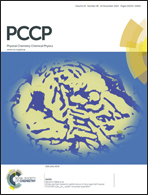Nitrogen-doped carbon supports with terminated hydrogen and their effects on active gold species: a density functional study†
Abstract
In order to disclose the reason that the N-doped carbon support can enhance the stability of Au-based catalysts for acetylene hydrochlorination, we established a big graphene cluster model of C110H28 to investigate the effect of different nitrogen-doped carbon supports on three kinds of gold species models of Au dimers, Au2Cl2 and Au2Cl6, through DFT calculations. Comparing the adsorption energy of each Au complex and the transferred charge from the support to the Au complex, it is observed that on the N-doped support GRN-I (the pyridinic N-doped graphene) the adsorption energies of the Au dimer, Au2Cl2 and Au2Cl6, are much higher than those on other three kinds of supports, and the Au complex accepts most of the transferred charges from the support of GRN-I. The effect of different supports on the adsorption of C2H2 and HCl was studied on Au2Cl6/supports, suggesting that the co-adsorption of both reactants occurs on Au2Cl6/GRN-I. The results indicate that the N-doped support of GRN-I can stabilize the gold species Au2Cl6 and enhance the interaction between Au2Cl6 and HCl, which can inhibit the reduction of Au3+ and then increase the long-term stability of Au-based catalysts.


 Please wait while we load your content...
Please wait while we load your content...